The prototype for a Japanese-built space shuttle crashed on landing Tuesday, breaking its left wing and nose cone. The 4-metre unmanned prototype was lifted by balloon in Sweden to an altitude of 21 kilometres and then plunged back to Earth, reaching 80% the speed of sound. Unfortunately, two of its three parachutes failed to open and it had a hard landing. Controllers got the aerodynamic data they needed, but the prototype is likely too damaged to be used again for future tests.
Similar Solar System Discovered
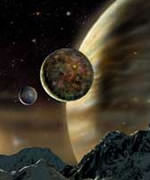
Image credit: PPARC
A team of international astronomers have discovered a planet which is remarkably similar to Jupiter. This new planet circles a star called HD70642 (in the constellation of Puppis) 90 light-years from Earth. It’s twice the mass of Jupiter and its orbit is nearly circular around HD70642 at a distance similar to Jupiter’s from our own Sun. Furthermore, there don’t seem to be any larger planets closer to the star. This planetary discovery is the most similar to our own solar system found so far.
Astronomers looking for planetary systems that resemble our own solar system have found the most similar formation so far. British astronomers, working with Australian and American colleagues, have discovered a planet like Jupiter in orbit round a nearby star that is very like our own Sun. Among the hundred found so far, this system is the one most similar to our Solar System. The planet’s orbit is like that of Jupiter in our own Solar System, especially as it is nearly circular and there are no bigger planets closer in to its star.
“This planet is going round in a nearly circular orbit three-fifths the size of our own Jupiter. This is the closest we have yet got to a real Solar System-like planet, and advances our search for systems that are even more like our own,” said UK team leader Hugh Jones of Liverpool John Moores University.
The planet was discovered using the 3.9-metre Anglo-Australian Telescope [AAT] in New South Wales, Australia. The discovery, which is part of a large search for solar systems that resemble our own, will be announced today (Thursday, July 3rd 2003) by Hugh Jones (Liverpool John Moores University) at a conference on “Extrasolar Planets: Today and Tomorrow” in Paris, France.
“It is the exquisite precision of our measurements that lets us search for these Jupiters – they are harder to find than the more exotic planets found so far. Perhaps most stars will be shown to have planets like our own Solar System”, said Dr Alan Penny, from the Rutherford Appleton Laboratory.
The new planet, which has a mass about twice that of Jupiter, circles its star (HD70642) about every six years. HD70642 can be found in the constellation Puppis and is about 90 light years away from Earth. The planet is 3.3 times further from its star as the Earth is from the Sun (about halfway between Mars and Jupiter if it were in our own system).
The long-term goal of this programme is the detection of true analogues to the Solar System: planetary systems with giant planets in long circular orbits and small rocky planets on shorter circular orbits. This discovery of a -Jupiter- like gas giant planet around a nearby star is a step toward this goal. The discovery of other such planets and planetary satellites within the next decade will help astronomers assess the Solar System’s place in the galaxy and whether planetary systems like our own are common or rare.
Prior to the discovery of extrasolar planets, planetary systems were generally predicted to be similar to the Solar System – giant planets orbiting beyond 4 Earth-Sun distances in circular orbits, and terrestrial mass planets in inner orbits. The danger of using theoretical ideas to extrapolate from just one example – our own Solar System – has been shown by the extrasolar planetary systems now known to exist which have very different properties. Planetary systems are much more diverse than ever imagined.
However these new planets have only been found around one-tenth of stars where they were looked for. It is possible that the harder-to-find very Solar System-like planets do exist around most stars.
The vast majority of the presently known extrasolar planets lie in elliptical orbits, which would preclude the existence of habitable terrestrial planets. Previously, the only gas giant found to orbit beyond 3 Earth-Sun distances in a near circular orbit was the outer planet of the 47 Ursa Majoris system – a system which also includes an inner gas giant at 2 Earth-Sun distances (unlike the Solar System). This discovery of a 3.3 Earth-Sun distance planet in a near circular orbit around a Sun-like star bears the closest likeness to our Solar System found to date and demonstrates our searches are precise enough to find Jupiter- like planets in Jupiter-like orbit.
To find evidence of planets, the astronomers use a high- precision technique developed by Paul Butler of the Carnegie Institute of Washington and Geoff Marcy of the University of California at Berkeley to measure how much a star “wobbles” in space as it is affected by a planet’s gravity. As an unseen planet orbits a distant star, the gravitational pull causes the star to move back and forth in space. That wobble can be detected by the ‘Doppler shifting’ it causes in the star’s light. This discovery demonstrates that the long term precision of the team’s technique is 3 metres per second (7mph) making the Anglo-Australian Planet Search at least as precise as any of the many planet search projects underway.
Original Source: PPARC News Release
Opportunity Launch Delayed Again
The launch of NASA’s second Mars Exploration rover, Opportunity, has been delayed again to Monday, July 7 as early as 0243 GMT (10:43 pm EDT Sunday). The delay will give technicians time to ensure that the booster’s cork insulation is properly adhered. If all goes well, Opportunity will blast off from the Kennedy Space Center in Florida on board a Delta 2 rocket and follow its partner spacecraft, Spirit, already en route to the Red Planet. Launch windows for the spacecraft are available until July 15.
Partial Fix for SOHO
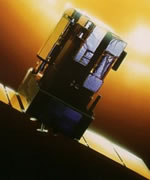
Image credit: ESA
After performing several tests on the troubled SOHO spacecraft, engineers believe they have a solution to ensure that the spacecraft doesn’t have any blackout periods. The pointing mechanism on SOHO’s high-gain antenna malfunctioned on June 27, 2003. Controllers have figured out a way to use larger ground-based receivers which can receive data from the low-gain antenna for a longer period, and receive all the data that SOHO needs to send. Engineers will continue to fix the problem with the high-gain antenna’s motor.
After a number of tests and new insights, SOHO engineers now say there will be no ‘blackout’ periods for SOHO science data.
High-rate transmissions from the Solar and Heliospheric Observatory (SOHO) were initially interrupted on 27 June 2003. The interruption was expected due to a recent malfunction in the pointing mechanism of the spacecraft’s high-gain antenna (HGA). The loss of signal occurred on a 26-metre station of NASA?s Deep Space Network (DSN).
Until 30 June 2003, however, the spacecraft continued beaming down its science data, which were successfully picked up by larger 34-metre DSN stations (when available). In addition, dumping on-board recorder data during these contacts has further reduced data losses so far.
On 30 June 2003, the 70-metre DSN station in Madrid, Spain, successfully received high-rate science data through SOHO’s omnidirectional on-board low-gain antenna. SOHO normally uses this antenna only for low-rate telemetry in emergencies, and the antenna does not need to be repointed.
Successful switch
Even better, when high-rate telemetry was lost on 1 July 2003, during a 34-metre station pass, engineers successfully switched SOHO into a medium-rate telemetry mode, using the low-gain antenna. In medium rate, all real-time science telemetry can be downlinked during station passes. However, on-board recorder dumps are not possible in this mode.
The relatively late occurrence of the initial loss of contact means that the effective SOHO’s HGA antenna beam width is larger than anticipated. Also, since the 34-metre stations are much quieter than the smaller stations, you can use them for longer time periods than expected. Being able to transmit science data through the on-board low-gain antenna using 70- and 34-metre stations therefore means that there will be no hard blackout periods for SOHO science data, given sufficient ground station resources.
Minor losses
However, 34- and 70-metre stations are in higher demand than the 26-metre stations that SOHO normally relies on. Some data losses are therefore expected every day during the 2-3 week periods. “We’re now talking only moderate fractions per day every day during the 2-3 week periods,” says Bernhard Fleck, ESA?s SOHO Project Scientist.
SOHO scientists expect full high-rate telemetry coverage, even on 26-metre stations, to resume on or about 14 July 2003. To achieve this, they will make the spacecraft roll 180? around its Sun-pointing axis in a manoeuvre currently planned for 8 July 2003.
Original Source: ESA News Release
Space and Astronomy Books for July, 2003
It’s July already, time to organize your summer reading. Universe Today has a list of all the space and astronomy books scheduled for publication in July, 2003. I’ve provided a list of all the books, as well as the Author and a brief description from the publisher. I’ve also got links where you can buy them in the US, UK and Canada. If there’s something that interests you, just pre-order it and you’ll get it days after release. If I get any review copies, I’ll provide additional links to my reviews.
Of course, you can also put in reservations at your local library and beat the crowds. 🙂
| Image | Title | Author | Description | Amazon US | Amazon UK | Amazon Canada |
| To the End of the Solar System: The Story of the Nuclear Rocket | James A. Dewar | Chemically propelled rockets can lift less than 5 percent of their take-off weight into orbit, a fact that could forever limit the space program. Nuclear-powered rockets, however, with their superior thrusting power and speed, are radically different. So argues James A. Dewar in the only comprehensive history ever written of the nuclear rocket project. | US | UK | CAN | |
| ***image6*** | The Future of Theoretical Physics and Cosmology | Based on lectures given in honor of Stephen Hawking’s 60th birthday, this book comprises contributions from the world’s leading theoretical physicists. Popular lectures progress to a critical evaluation of more advanced subjects in modern cosmology and theoretical physics. | US | UK | CAN | |
| ***image8*** | Perilous Planet Earth: Catastrophes and Catastrophism through the Ages | Trevor Palmer | Reviewing our present concerns about the threat from natural disasters, such as asteroids and immense volcanic eruptions, within the context of history, this volume is written at a level that interests academics as well as general readers. | US | UK | CAN |
| ***image9*** | Seeing in the Dark: How Amateur Astronomers Are Discovering the Wonders of the Universe | Timothy Ferris | Paperback Edition | US | UK | CAN |
| Astronomy: A Beginner’s Guide to the Universe | Eric Chaisson, Steve McMillan | Like its best-selling predecessor, Astronomy Today (1993), this text presents scientific literacy in the context of astronomy, teaching students to think critically and analytically about the physical world and the development of science. | US | UK | CAN | |
| ***image7*** | Galileo’s Mistake: A New Look at the Epic Confrontation between Galileo and the Church | Wade Rowland, Allen Thomas | US | N/A | N/A | |
| ***image10*** | Star Watch: The Amateur Astronomer’s Guide to Finding, Observing, and Learning About over 125 Celestial Objects | Philip S. Harrington | The night sky is alive with many wonders??distant planets, vast star clusters, glowing nebulae, and expansive galaxies, all waiting to be explored. Let respected astronomy writer Philip Harrington introduce you to the universe in Star Watch, a complete beginner?s guide to locating, observing, and understanding these celestial objects. | US | UK | CAN |
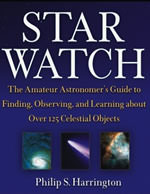
|
Dictionary of Minor Planet Names | Lutz D. Schmadel | US | UK | CAN | |

|
Firefly Atlas of the Universe | Patrick Moore | The Firefly Guide to the Universe is an encyclopedic examination of the stars, planets, and universe with the latest, most comprehensive information currently available. The book features the latest images from the Hubble Space Telescope which are put into context with clear and detailed text. | US | UK | CAN |
| ***image11*** | Traveler’s Guide to Mars: The Mysterious Landscapes of the Red Planet | William K. Hartmann | Paperback Edition | US | UK | CAN |
| Cataclysmic Variable Stars | Brian Warner | Cataclysmic variables are interacting binary stars that contain a white dwarf accreting from an orbiting companion. The study of these stars is currently undergoing an exciting renaissance as it embraces observations at all wavelengths. | US | UK | CAN | |

|
It Came from Outer Space: Everyday Products and Ideas from the Space Program | Marjolijn Bijlefeld, Robert L. Burke | What do anthrax protection, golf clubs, and cordless power tools have in common? Each was invented or improved with technology first developed for the space program. This book tells the story of 67 of the most consumer-friendly products born of space-related research. | US | UK | CAN |

|
Coming of Age in the Milky Way | Timothy Ferris | Paperback Edition | US | UK | CAN |
Mars Express Power Problems
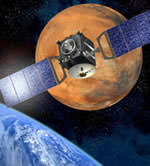
Image credit: ESA
Operators with the European Space Agency are currently testing various systems on the Mars Express spacecraft, and it looks like there’s a bit of a problem. It seems that there’s a connection problem between the spacecraft’s solar panels and its power conditioning system. If they can’t fix this problem, the spacecraft will only be able to operate at 70% power; however, it will still be able to perform nearly all of its objectives for the mission. Ground engineers will begin tests on the Beagle 2 lander on July 4.
ESA?s Mars Express spacecraft is progressing further every day on its journey to the Red Planet. Everything is set for arrival at Mars on the night of 25 December 2003, after a journey of about 400 million kilometres. In the weeks since its launch, engineers have started to thoroughly test the spacecraft and its equipment.
This testing phase is standard for all spacecraft on the way to their destination. Known as commissioning, it began 3 weeks after the launch. During this time, ground controllers sent signals to each of the orbiter’s seven instruments to switch them on and verify their health status.
As well as commissioning the instruments, the ground controllers also tested each of the spacecraft?s subsystems. There was a thrilling moment when one of the on-board computer memory units, known as the Solid State Mass Memory (SSMM), seemed to not respond properly during the instruments check-out. Good progress has been made on this issue in the last few days: a test involving all instruments was completed successfully by recording and recovering the data through the SSMM.
Unfortunately, during the commissioning of the power subsystem, ground engineers recorded an interconnection problem between the solar arrays and the power conditioning unit on board the spacecraft. This means approximately 70% of the power generated by the solar arrays is available for the satellite and its payload to use. This anomaly has no effect on the state of the spacecraft and has no impact on the mission during the whole trip to Mars, including the orbit insertion phase once at destination.
Despite this, the experts analysing the anomaly believe that even with this power shortage, the nominal Mars observation mission will be achievable. However, satellite payload operations may have to be reviewed for certain short periods of the mission.
Ground engineers are now preparing for the last of the payload?s tests: the Beagle-2 lander will undergo its check-out on 4-5 July 2003. The experts are looking confidently to it. “In fact,” says Rudolf Schmidt, Mars Express Project Manager, “overall, the spacecraft is in good shape. We are simply getting to know its personality.”
Original Source: ESA News Release
NASA Shuffles Shuttle Management Team
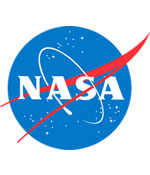
Image credit: NASA
NASA removed several managers from the space shuttle team on Wednesday as part of its response to the Columbia accident investigation. The manager for the vehicle engineering office was reappointed to a similar position at the Langley Research Center, while the head of the mission management team and manager of systems integration appear to have just been let go. NASA also named new candidates who will fill the positions.
Space Shuttle Program Manager Bill Parsons today announced several key leadership changes within the office as it reorganizes and evolves following the Columbia accident.
?This is a critical time for the agency and the shuttle program and I believe these changes and additions to my staff prepares us to return to flight as soon as possible and, most importantly, as safely as possible,? Parsons said.
N. Wayne Hale, Jr., is named Acting Deputy Manager, Space Shuttle Program. He will return to the Johnson Space Center from the Kennedy Space Center where he has served as Manager, Launch Integration, since February.
Hale joined NASA JSC in 1978 and has served in several senior technical and managerial positions. He began his managerial career in 1985 as Head, Communications Systems Section. From 1988 to 2002 he served as a flight director including the Ascent and Entry Flight Director for 28 Space Shuttle flights. He earned his Bachelor of Science in Mechanical Engineering in 1976 from Rice University and a Master of Science degree in Mechanical Engineering in 1978 from Purdue University.
Steve M. Poulos, Jr., becomes Acting Manager, Orbiter Project Office at JSC. He joins the shuttle program from the Engineering Directorate where he most recently was Chief, Crew and Thermal Systems Division.
Poulos joined NASA JSC in 1989 and has held positions including Deputy Chief, Extravehicular Activity (EVA) Equipment Branch, and Chief, EVA and Spacesuit Systems Branch in the Engineering Directorate; Deputy Manager, EVA Project Office; and Deputy Manager, Program Integration Office, International Space Station Program. He earned his Bachelor of Science in Metallurgical Engineering in 1982 from Penn State University and a Master of Business Administration in 1992 from the University of Houston ? Clear Lake.
Edward J. Mango becomes Deputy Manager, Orbiter Project Office. He has been the technical assistant to the Space Shuttle Program Manager on detail from the Kennedy Space Center.
Mango joined NASA at the Kennedy Space Center in 1986 and has held positions that include Lead Project Engineer for the External Tank and Solid Rocket Motors; Lead Project Engineer for Atlantis during the Shuttle-Mir Program; Shuttle Project Engineer; and Shuttle Launch Manager. Most recently he served as the Recovery Director for the Columbia debris recovery effort in East Texas. Mango earned his Bachelor of Science in Aerospace Engineering in 1981 from Parks College of Saint Louis University and a Master of Science in Engineering from the University of Central Florida in 1993.
John P. Shannon is named Acting Manager, Flight Operations and Integration. Most recently, he served as Lead Flight Director on Discovery?s STS-102 mission in March 2001. Following Columbia?s accident, Shannon served as the Deputy Director of the Columbia Task Force that served as the interface between NASA and the Columbia Accident Investigation Board.
Shannon joined NASA JSC in 1987 and has served in several senior technical and managerial positions. He began his managerial career in 1992 as Head, Guidance and Control Systems Section. From 1993 to 2003 he served as a flight director, including Ascent and Entry Flight Director for 11 Space Shuttle flights. He earned his Bachelor of Science in Aerospace Engineering in 1987 from Texas A & M University. In 2002 he was selected to participate in the inaugural class of the JSC Leadership Development Program. In addition, he has been selected to attend the Harvard Program for Management Development through the NASA Fellowship Program.
John F. Muratore is named Manager, Systems Integration Office. He most recently was Assistant to the Director of Engineering at JSC.
Muratore joined NASA JSC in 1983 and has held positions including Chief, Reconfiguration Management Division, Space Shuttle Flight Director, and Chief, Control Center Systems Division in the Mission Operations Directorate; and Associate Director and Deputy Manager, Advance Development Office within the Engineering Directorate. He earned his Bachelor of Science in Electrical Engineering in 1979 from Yale University and a Master of Science in Computer Science in 1988 from the University of Houston – Clear Lake.
Original Source: NASA News Release
Helios Crash Investigation Begins
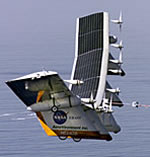
Image credit: NASA
NASA has recovered 75% of the solar-powered Helios aircraft after it crashed into the Pacific Ocean off the coast of Hawaii last week. Researchers say that the unmanned prototype was at an altitude of only 900 metres when it experienced control problems which shook the aircraft violently and caused it to crash. Unfortunately, none of the recovered debris can be reusable because of damage from the salt water. This was its tenth test flight.
As much as 75 percent, by weight, of the Helios Prototype solar electric airplane that crashed into the Pacific Ocean June 26 has been recovered from the waters several miles west of the Hawaiian island of Kauai.
The Helios Prototype is part of a NASA Dryden Flight Research Center project to develop unmanned aerial vehicle (UAV) technologies to enable UAVs to perform a variety of long-duration missions including environmental monitoring and telecommunications relay services. Helios was built and operated by AeroVironment, Inc. of Monrovia, Calif.
Researchers said the 247-ft. remotely piloted flying wing aircraft, operating on solar cell power, was at about 3,000 feet in restricted Navy test range airspace when it experienced control difficulties that resulted in severe oscillations before Helios sustained some structural damage and went down. AeroVironment’s solar aircraft team has previously conducted nine successful flights with the Helios Prototype and more than 40 on predecessor solar aircraft. NASA has convened a mishap investigation board on Kauai to determine the cause of the crash.
Among debris recovered with the help of the U.S. Navy?s Pacific Missile Range Facility and the Niihau Ranch were the two hydrogen fuel tanks carried by Helios in a quest to validate fuel cell electric power technology for airborne applications. Helios team members say none of the recovered pieces will be reusable because of damage and salt-water contamination. They say the crash does not pose environmental hazards. Formal recovery efforts ended on June 28, but debris patrols of the beaches on the west side of Kauai continue.
Gravitational Waves Could Define Pulsar Spin
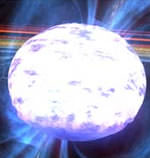
Image credit: NASA
It’s possible that the spin rate of pulsars is limited by gravitational radiation according to new data gathered by NASA’s Rossi X-ray Timing Explorer – a phenomenon predicted by Albert Einstein. Pulsars are the core remains of exploded stars, no larger than 15 kilometres across, and some rotate as fast as once/millisecond. Scientists believe that as a pulsar speeds up, it flattens out, and the distortions in its shape cause it to emanate waves of gravity which stop it from rotating so fast it flies apart.
Gravitational radiation, ripples in the fabric of space predicted by Albert Einstein, may serve as a cosmic traffic enforcer, protecting reckless pulsars from spinning too fast and blowing apart, according to a report published in the July 3 issue of Nature.
Pulsars, the fastest spinning stars in the Universe, are the core remains of exploded stars, containing the mass of our Sun compressed into a sphere about 10 miles across. Some pulsars gain speed by pulling in gas from a neighboring star, reaching spin rates of nearly one revolution per millisecond, or almost 20 percent light speed. These “millisecond” pulsars would fly apart if they gained much more speed.
Using NASA’s Rossi X-ray Timing Explorer, scientists have found a limit to how fast a pulsar spins and speculate that the cause is gravitational radiation: The faster a pulsar spins, the more gravitational radiation it might release, as its exquisite spherical shape becomes slightly deformed. This may restrain the pulsar’s rotation and save it from obliteration.
“Nature has set a speed limit for pulsar spins,” said Prof. Deepto Chakrabarty of the Massachusetts Institute of Technology, lead author on the journal article. “Just like cars speeding on a highway, the fastest-spinning pulsars could technically go twice as fast, but something stops them before they break apart. It may be gravitational radiation that prevents pulsars from destroying themselves.”
Chakrabarty’s co-authors are Drs. Edward Morgan, Michael Muno, and Duncan Galloway of MIT; Rudy Wijnands, University of St. Andrews, Scotland; Michiel van der Klis, University of Amsterdam; and Craig Markwardt, NASA Goddard Space Flight Center. Wijnands also leads a second Nature letter complementing this finding.
Gravitational waves, analogous to waves upon an ocean, are ripples in four-dimensional spacetime. These exotic waves, predicted by Einstein’s theory of relativity, are produced by massive objects in motion and have not yet been directly detected.
Created in a star explosion, a pulsar is born spinning, perhaps 30 times per second, and slows down over millions of years. Yet if the dense pulsar, with its strong gravitational potential, is in a binary system, it can pull in material from its companion star. This influx can spin up the pulsar to the millisecond range, rotating hundreds of times per second.
In some pulsars, the accumulating material on the surface occasionally is consumed in a massive thermonuclear explosion, emitting a burst of X-ray light lasting only a few seconds. In this fury lies a brief opportunity to measure the spin of otherwise faint pulsars. Scientists report in Nature that a type of flickering found in these X-ray bursts, called “burst oscillations,” serves as a direct measure of the pulsar’s spin rate. Studying the burst oscillations from 11 pulsars, they found none spinning faster than 619 times per second.
The Rossi Explorer is capable of detecting pulsars spinning as fast as 4,000 times per second. Pulsar break-up is predicted to occur at 1,000 to 3,000 revolutions per second. Yet scientists have found none that fast. >From statistical analysis of 11 pulsars, they concluded that the maximum speed seen in nature must be below 760 revolutions per second.
This observation supports the theory of a feedback mechanism involving gravitational radiation limiting pulsar speeds, proposed by Prof. Lars Bildsten of the University of California, Santa Barbara. As the pulsar picks up speed through accretion, any slight distortion in the star’s dense, half-mile-thick crust of crystalline metal will allow the pulsar to radiate gravitational waves. (Envision a spinning, oblong rugby ball in water, which would cause more ripples than a spinning, spherical basketball.) An equilibrium rotation rate is eventually reached where the angular motion shed by emitting gravitational radiation matches the angular momentum being added to the pulsar by its companion star.
Bildsten said that accreting millisecond pulsars could eventually be studied in greater detail in an entirely new way, through the direct detection of their gravitational radiation. LIGO, the Laser Interferometer Gravitational-Wave Observatory now in operation in Hanford, Washington, and in Livingston, Louisiana, will eventually be tunable to the frequency at which millisecond pulsars are expected to emit gravitational waves.
“The waves are subtle, altering spacetime and the distance between objects as far apart as the Earth and the Moon by much less than the width of an atom,” said Prof. Barry Barish of the California Institute of Technology, the LIGO director. “As such, gravitational radiation has not been directly detected yet. We hope to change that soon.”
Original Source: NASA News Release
Investigators Needed Better Launch Photos
Investigators working on the Columbia accident said this week that the launch photos from a key camera were too blurry to provide useful images. Sharper images of foam falling from the external tank and crashing into the wing might have given NASA more reason to take the situation seriously. The investigators recommended that NASA upgrade its camera systems for future launches, and consider additional views from airplanes and ships.
